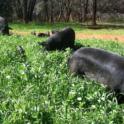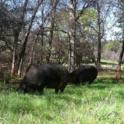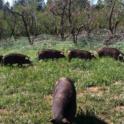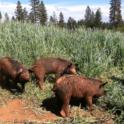Pasture-based Swine
Raising Swine on Pasture
NEW: New California Antibiotic Rules for Livestock Producers
As of January 1, 2018, producers will need a veterinarian prescription for medically important antibiotics. For more information, go to the California Department of Food and Agriculture's Antimicrobial Use and Stewardship website.
For a brief overview, check out this post on the Ranching in the Sierra Foothills blog!
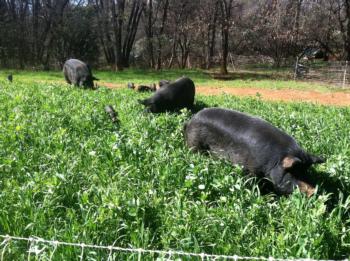
• Breeding or feeder/stocker pigs? There are many advantages to growing a self-sustaining, "closed" herd. Parasites and disease issues can be effectively managed and breeding can develop specific qualities in your product. But a breeding operation requires very specific management. Feeder pigs bought in from an outside breeding operation offer more flexibility of management.
• Breed selection — Modern pigs have been bred for mass production in highly controlled environment. Research alternative and heritage breeds that may be able maximize the feed value of the pasture and tolerate the climate of your area. Heritage breeds may also help create a niche market for your pork product. Heritage breed piglets are also more rare and therefore more valuable. If you are selling live pigs, a heritage breed could be a profitable choice.
• Available land — Is your pasture irrigated or dryland? Do you have woodland areas or crop residues to graze your herd on? Are you planning to grow forage crops specifically for your pigs? How long will grazed areas need for adequate regrowth? All of these factors and more will impact your stocking density and the rate at which you will need to move your herds. Like in most pasture-based livestock systems, moving the pigs frequently will result in the lowest impact on the land. Integral to pasture-based management is land recovery- adequate rest is a crucial part of pasture management. The period of rest will depend on the type of vegetation, irrigation, and season.
• Supplemental feed — Pigs have a high protein requirement (especially lactating/gestating sows and weaning piglets) and will need supplemental feed. Look into feed requirements and the types of feed available in your area. A healthy hog rations should be 14% crude protein. It is possible to supplement a pigs diet with alternative feed such as high quality hay, brewers barley, and vegetable trimmings. Pigs need fresh food to be healthy, do not overfeed with spoiled products.
• Shelter — Though hardy and well-adapted to outdoor living, pigs need shelter from weather and temperature extremes. Mobile shelters need to be light enough to move from paddock to paddock but strong enough to withstand the curiosity of pigs. Classic A-Frame designs are inexpensive, strong, and mobile.
• Drinking Water — Developing a fresh drinking water system that cannot be destroyed by the pigs will be a challenge. Pigs want to wallow in wet ground and they will break a drinking water system to create a wallow.
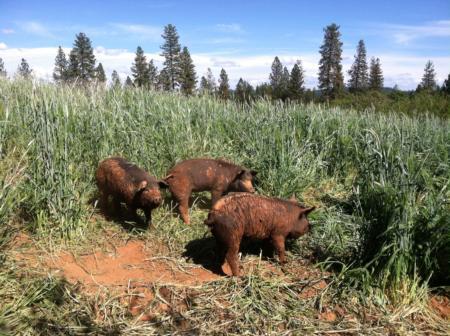
• Wallow management — Pigs do not sweat and will bathe in water, mud or dirt to regulate temperature. Pigs love to wallow in mud and if a wallow is not provided, they will create one by any means necessary posing a major problem for pasture management. Some farms choose to not provide wallows for their pigs. Other farms have developed hybrid wallow systems with portable sprinklers or misters. In determining how to best manage wallows you will need to pay close attention to the health of your pasture.
• Fencing — Pigs are very inquisitive animals. Your mobile paddocks will need sturdy fencing. Many PBSM operations utilize electric netting, tape or strand. You can energize your fences directly off of the grid or you can use batteries in the field. Learn about setting a hot fence as this will be a very important component of managing your hogs and your pastures.
• Pest and disease management — Be sure to find a large animal veterinarian to help with healthcare of your animals. Learn about common pests and disease and how to avoid them by creating healthy living environments for your pigs. Pigs on pasture will be at risk for internal and external parasites.
Resources
Forages for Swine, University of Missouri Extension
Pasture-Based Swine Management, University of Arkansas
Profitable Pork, SARE
Raising Organic Pigs: A Guide to USDA Certified Organic Requirements, ATTRA
Marketing Pasture-based Swine
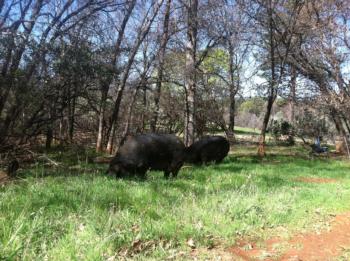
- Whole animal or cut and wrapped parts? While it is tempting to offer chops, roasts and sausage at your local farmers' market, you may find that you are able to move the whole hog, so to speak. Be sure to do a cost analysis of these two products to compare profit margins. If you decide to put your own label on your packaged products, make sure you are following appropriate legal protocols.
- Slaughter Regulation- All pork must be slaughtered and processed at a facility inspected by the USDA. For a list of all USDA inspected facilities, follow this link.
- Cold Storage- One hog is going to fill the freezer. How quickly are you moving your product? How long will you need to store your product? How will you maintain the cold chain from slaughter to market? Some slaughter facilities will offer delivery for an added fee- do a price comparison to see if this is a good choice for your operation.
- Food Safety- If you don't have one yet, it is a good idea to create a Hazard Analysis and Critical Control Points (HACCP) plan for your farm. This is especially important if your animal operation is integrated into fruit and vegetable crop production.


